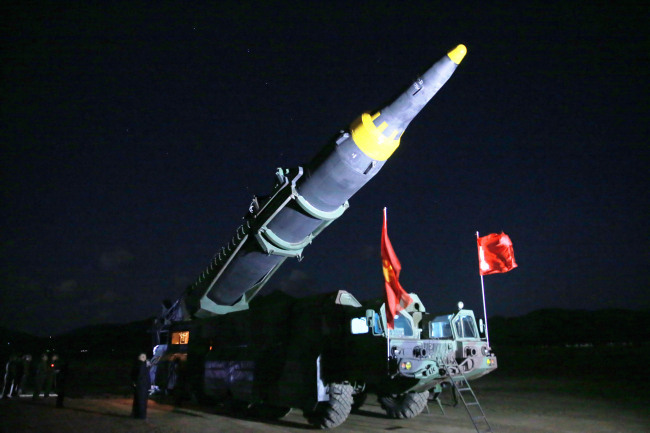With North Korea threatening to fire off intermediate-range ballistic missiles into the waters near the US island Guam, debate emerged Thursday over whether the communist regime would push ahead with its plan despite stern warnings from the US and its allies.
According to the North’s state-run news agency, Gen. Kim Rak-gyom, commander of the Strategic Forces of the Korean People’s Army, said it is examining an “enveloping strike” of Guam with four Hwasong-12 missiles that he said would fly 3,356.7 kilometers before landing 30 to 40 kilometers away from the island.
In interviews with The Korea Herald, most experts agreed that the North has raised the stakes by coming up with a more detailed plan amid doubts over whether the regime would take the risk of inviting a US military response.
“North Korea is likely to push ahead with the missile launches, if they think they can get away with it,” said Yang Uk, a senior research fellow at the Korea Security and Defense Forum. “Unless the US describes it as a declaration of war, there is no reason not to fire the missiles.”
Such action would provoke “severe countermeasures” from the US, such as interception via its advanced ground and naval interceptors at Guam, such as the Terminal High Altitude Area Defense system and SM-3 missiles, as well as a pre-emptive strike against the North’s missile site, Yang noted.
Kim Dong-yup, a missile expert and professor at Kyungnam University’s Far East Institute, agreed that the North would carry out its plan, adding that the reclusive regime would not have announced such plans unless it was fully prepared for a US response.
 |
Intermediate-range ballistic missile Hwasong-12. Yonhap |
But doubts still persist among analysts over whether North Korea would go as far as to run the risk of inviting a US military response, which would bring about total annihilation of the reclusive regime and its leader Kim Jong-un.
“If North Korea fired the missiles, it would constitute an act of provocation of war,” said Hong Hyun-ik, a senior researcher at Sejong Institute in Seoul. “It’s more about scarring off the US and its allies. I don’t think they will take the risk of an all-out war with the US.”
Yang Moo-jin, a professor at the University of North Korean Studies,echoed the view, saying North Korea’s threat to attack Guam is a “political message” designed to enhance its leverage during a potential one-on-one talk with the US.
Some analysts questioned the accuracy and reliability of the North’s ballistic missiles, saying the regime has yet to acquire technology to deliver the projectile to a distant target in Guam with an accuracy of 3,356.7 kilometers. The island is located about 3,400 kilometers from the Korean Peninsula.
In an interview with Bulletin of the Atomic Scientists on Wednesday, nuclear expert Siegfried Hecker, who has visited North Korea’s nuclear facilities a number of times, said he doubted that the country is capable of attacking Guam.
“North Korea likely made some of the key measurements required to define those extreme conditions during the two July tests (of intercontinental ballistic missiles), but I can’t imagine it has learned enough to confidently make a warhead that is small and light enough and sufficiently robust to survive,” he said.
Shin In-gyun, president of Korea Defense Network, said although North Korea is likely to fire off a missile, it is very difficult for the US to shoot down incoming projectiles and conduct military action in response.
The analyst claimed the North’s launch would not warrant a US military response, saying if the missiles landed in waters 30 to 40 kilometers from Guam as promised, it would not breach US territorial waters, which extend about 22 kilometers from the island.
“It’s such a delicate plan. If the North really fired the missiles, they would fly over the Japanese territory and land in international water near the US Island. It’s like asking both the US and Japan, ‘What are you going to do?” Shin said.
By Yeo Jun-suk (
jasonyeo@heraldcorp.com)








